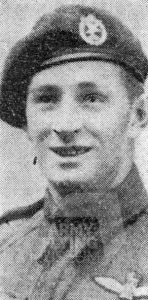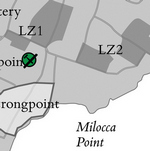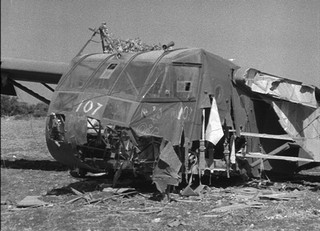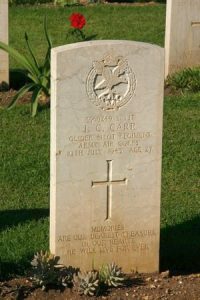Glider 107 landed near an Italian garrison who shot at it the instant it landed, and then patrolled for survivors.
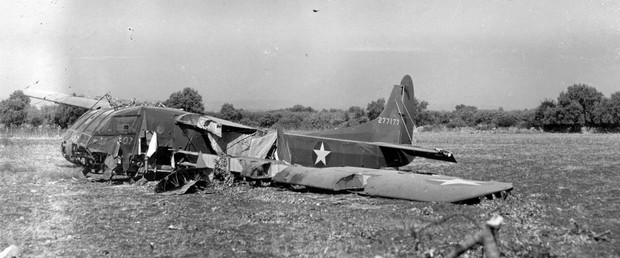
Glider: Waco CG-4A number 107, name “Rocket”, serial no. 277177.
Glider carrying: Half of 10 Platoon, A Company, 1st Battalion of the Border Regiment.
Troops’ objective: Outskirts of Syracuse.
Manifest
1 Offr
15 ORs
Out of 13 gliders carrying men of A Company, only two landed in Sicily. Glider 107 was one. The other was Glider 95, which carried men attached to Company HQ. We do not have a list of names of the Border troops in Glider 107, but Pvt Hartshorn later remembered three besides himself:
Lt Reese, R M A
Pvt Hartshorn, Andrew
Pvt Clark
Pvt Sykes
Glider Pilot’s Report
Glider allotted Landing Zone: LZ 2.
“Good tow. Intercomn went u/s half way over. Glider released on correct run in at 2240 hrs at 1600 ft approx 400 yds from coast and landed successfully in field next to L.Z.”
First Glider Pilot: S/Sgt Carr, James
Second Glider Pilot: S/Sgt Matthews
Carr was killed, so presumably the report was furnished by Matthews.
It’s not exactly correct in implying the landing was close to the LZ. In fact Glider 107 landed WSW of its target LZ 2 [map], about one kilometer from the LZ’s closest point and two from its centre. However it was certainly good enough, and far better than many, being not far from LZ 1 and a direct route northwards towards the troops’ objectives.
An examination after the battle revealed:
“Landed in middle of good sod surfaced field, knocked down telephone pole and power lines running across field. Left wing struck telephone pole knocking off one-half the wing. Lower portion of nose damaged from high speed landing.”
Carr came from the village of Clydach, near Swansea in Wales. A letter in the archives of the Army Flying Museum, apparently from another Clydach man, recounts what happened to him:
“I met two sergeants of Army Airborne Corps [glider pilots]. They were friends of the boy Carr from Sunny Bank. You know he was posted “missing” in the Sicily affair. They told me that he had been killed. He had landed his Glider successfully and, meeting small-arms fire, had made a successful get-away to a hide-out.
He then returned to his Glider and was shot while doing so. His co-pilot named Matthews ran to his aid but found that Carr was already dead. The two sergeants said that they had lost a good comrade and were sorry about it. Apparently Carr was an extremely popular member of his squadron; he excelled in both football and cricket, and above that, was an extremely capable Glider-pilot. I am so sorry to have heard of his death. […]
Perhaps you would like to pass on this information. However sad it is, I am sure his parents – he was their only boy – would like to know that he did his part and did it well.
The praises from his two companions were quite spontaneous, and although it was sad hearing their story, it made me feel very proud to think that a Clydach lad had carried out his job exceedingly well, for he landed his plane and all his comrades without casualty. He is buried near Syracuse. I am sorry this airgraph contains such a sad story.”
Tug Pilot’s Report
Tug: Albemarle Mk I [photo], letter G, number P1434, 296 Squadron, 38 Wing RAF.
Takeoff: 1938 hrs (on time) 9 July 1943, Airstrip F, Goubrine No. 1, Tunisia. Priority 17.
Tug return: 0100 hrs (10 mins early) 10 July 1943.
Pilot: F/O D J Boyer, with F/O F T Croker, Sgt J W Hansen & Sgt H Lawson
Time of release: 2249 hrs
The brief report in 38 Wing’s “Summary of Interrogation Reports” is identical to the Air Landing Brigade’s (see above).
The Action
Glider 107 landed close to an Italian HQ in a farm called Casa Gallo [map]. The glider may also have been fired on from a nearby Italian strongpoint centred on another farm, called Masseria Palma. The glider came under fire as soon as it landed. Some 50 years later Hartshorn recalled:
“[We were] fired on as we crashed. Seven of us got away and we did not meet any of the Allies until Sun [the 11th] at about 4-00 pm [when] we met up with the SAS. Up till then we had only seen Italians.”
If Hartshorn’s memory is correct, then he and his fellow Borderers might have encountered the SAS SRS near a farm called Luogo Ulivo, where the SAS men had spent the night of the 10/11th. However it was not much more than 1000 yards north of where the glider landed, which would mean it took the Border men nearly two days to go about a kilometer, which seems unlikely.
Hartshorn’s use of the phrase “got away”, i.e. “escaped”, echoes the phrase “made a get-away to a hide-out” in the letter about Carr (see above). Perhaps Italian gunfire and Italian patrols kept the glider men pinned for quite a time. An Italian account emphasises this.
Casa Gallo was garrisoned by men of the 3rd Company of the Italian 385th Coastal Battalion. One of its officers was Lt Maurizio Rossi. He later recalled:
“About 21:30 on the 9th some 100 British gliders with about 2000 paratroopers landed in 3 Company’s sector. We were immediately put on alert and engaged in combat all night & part of following morning. […] After a careful sweep, we captured about 120 British [glider] troops, who were sent to Battalion HQ. After a relative calm until noon, we were attacked by a British seaborne battalion. We fought for an hour until we were overcome by their greater numbers. […] I was captured along with my CO Capt Lucchesi and about 40 men of 3 Company.”
Casa Gallo was captured on the 10th by the leading troops of 2 Royal Scots Fusiliers (RSF). A signal sent immediately afterwards reported:
“Military HQ at GALLO 127249 and in woods to WEST. Three crashed GLIDERS with wounded at same spot. Send ambulance for […] wounded via road 111242 -X rds 115241 to LA VILLA 116241.”
The route spelled out in the message had only recently been captured after fighting at both of the latter places and elsewhere along it, with some RSF casualties. These were presumably dealt with first. Plus vehicle unloading back at the beaches had been held up, so it is unlikely that any ambulances arrived any time soon. As a result, farm carts were usually the first form of ambulance.
With thanks to the Army Flying Museum for permission to use Carr’s photograph, and to quote from the letter about his death.
Carr is buried in the CWGC Cemetery at Syracuse.

